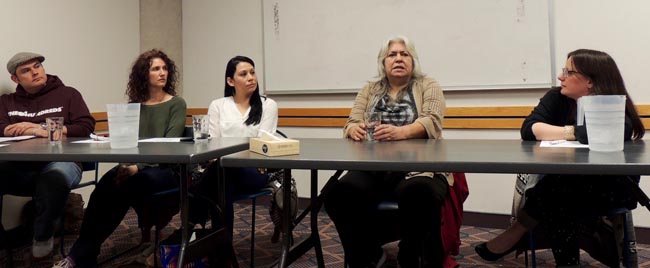Stories need to be protected

By Christine Smith (McFarlane)
TORONTO – At the opening of the roles and responsibilities of Indigenous storytelling panel at North York Library on April 16, inaugural writer in residence Cherie Dimaline spoke to a small crowd about the importance of story and the role it plays in our lives, especially when you are a writer.
“When you have a story, its never yours, you’re borrowing it, you’re using it, you’re growing from it, but it belongs to your people and you always need to acknowledge the land that it comes from, the people it comes from and the lineage it carries.,” said Dimaline. “When you tell stories in public spaces you have to be aware you cannot control how it’s interpreted and how it’s retold.”
“The idea of this panel came about when I spoke to Eden Robinson back in 2006 and 2007 and we talked about the responsibilities, and sort of the burdens she felt in putting her first book out. I asked her ‘what could these burdens possibly be?’”
Robinson explained to Dimaline: “I come from a community of storytellers and when my book was being crafted, I went to certain community members that carried stories of certain instances and ceremonies and I went with my draft and I asked them to tell me about the potlatch. They told me you can’t tell that story because it’s not your story to tell. They also said even if it’s your story through your family, it belongs to your family and when it leaves your community, it really needs to be guarded.”
The idea of the roles and responsibilities that come with Indigenous storytelling grew as Dimaline began putting out her own stories.
“You cannot control how a story is told and how it’s retold and you need to be aware of the implications of that,” she said. “It’s not that we don’t share stories because that’s how we ensure the survival of our traditions and how we carry on our culture but you have to be very specific about the responsibilities that certain stories have, and we have responsibilities to those stories, those stories are ceremonies in many cases and need to be protected.”
The most inspiring words came from traditional teacher and author Lee Maracle when an audience member asked “When you want to tell your stories, don’t you feel that there is an element of suppression in your stories because of intergenerational trauma?”
Maracle spoke about how trauma plays a context in the stories we tell.
“Trauma has a context right, and what happened to us is that we got disconnected from our original context but we reconnected again and that story is a beautiful story and so of course we are going to write it, it’s extraordinary,” said Maracle. “It’s a story of courage, and heroism, perseverance and brilliance to sit and figure out that your culture isn’t a shoebox under the bed just because some white guy told you; you lost it. It doesn’t make it so. It’s brilliant to figure that out. This context is so big – it’s a planet. The context is not traumatic. If you see the trauma in the context, its just a little tiny stone in a huge ocean and yes the ripples go out but we understand those ripples and we become a friend of them through story. I suppose that is how they influence story.”
Panelists included Lee Maracle (traditional teacher and author), Susan Blight (artist and broadcaster) Jamaias Dacosta (musical artist, writer and activist journalist and Jesse Thistle (academic and community researcher).


